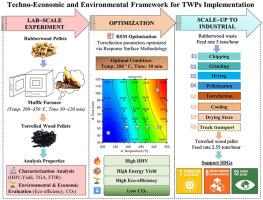Exploiting torrefied rubberwood pellets for sustainable energy in Southern Thailand: Integrated techno-economic and environmental optimization
IF 6.5
Q2 ENGINEERING, ENVIRONMENTAL
引用次数: 0
Abstract
This study investigates the potential of torrefied rubberwood pellets (TWP) as a sustainable biofuel, using waste from southern Thailand's wood processing industry. A multi-criteria framework combining experimental analysis, CO2 emission, and an Economic Environmental Index (EEI) was employed to optimize torrefaction conditions and evaluate industrial scalability. The optimal conditions were identified to be 288 °C for 30 min, resulting in a volumetric energy density of 16.10 GJ m−3 and an eco-efficiency of 0.16 %YE (kg CO2_eq/kg biomass)−1 USD−1. This demonstrates a critical balance between energy quality and environmental impact. Compared to conventional wood pellets, torrefaction reduced CO2 emissions by 27 %. GIS mapping was used to plan regional logistics routes, while scenario analyses demonstrated enhanced profitability (EEI ratio: 2.73) and carbon credit opportunities, reducing 2275 kg CO2_eq per ton of coal replaced. The study establishes TWP as a carbon-negative biofuel suitable for power generation and cement production, supporting Thailand's transition to a circular bioeconomy. By bridging technological innovation with regional waste valorization, this research provides a replicable model for sustainable biomass utilization in tropical agro-industrial contexts.

开发碳化橡胶木颗粒在泰国南部的可持续能源:综合技术经济和环境优化
本研究调查了碳化橡胶木颗粒(TWP)作为可持续生物燃料的潜力,使用来自泰国南部木材加工业的废物。采用实验分析、二氧化碳排放和经济环境指数(EEI)相结合的多准则框架来优化焙烧条件和评估工业可扩展性。最佳条件为288°C, 30 min,其体积能量密度为16.10 GJ m−3,生态效率为0.16% YE (kg CO2_eq/kg生物量)−1 USD−1。这表明了能源质量和环境影响之间的关键平衡。与传统木屑颗粒相比,焙烧减少了27%的二氧化碳排放量。GIS制图用于规划区域物流路线,而情景分析表明,提高了盈利能力(EEI比率:2.73)和碳信用机会,每吨替代煤炭减少2275 kg CO2_eq。该研究确定TWP是一种适用于发电和水泥生产的负碳生物燃料,支持泰国向循环生物经济过渡。通过将技术创新与区域废物增值相结合,本研究为热带农业工业环境下的可持续生物质利用提供了一个可复制的模型。
本文章由计算机程序翻译,如有差异,请以英文原文为准。
求助全文
约1分钟内获得全文
求助全文
来源期刊

Cleaner Engineering and Technology
Engineering-Engineering (miscellaneous)
CiteScore
9.80
自引率
0.00%
发文量
218
审稿时长
21 weeks
 求助内容:
求助内容: 应助结果提醒方式:
应助结果提醒方式:


